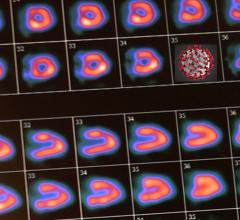
June 11, 2015 - At the 2015 Annual Meeting of the Society of Nuclear Medicine and Molecular Imaging (SNMMI), June 6-10 at the Baltimore Convention Center, Siemens Healthcare debuted new technologies designed to expand the capabilities and improve the productivity of molecular imaging. Symbia Evo, Siemens' new single-photon emission computed tomography (SPECT) system, boosts user productivity, providing facilities with more time to plan treatment schedules, personalize studies, serve additional patients and improve workflow efficiency.
Also at SNMMI 2015, Siemens unveiled the Biograph RT Pro edition. The machine leverages the positron emission tomography (PET) and computed tomography (CT) technologies of the Biograph mCT family of large-bore scanners for radiation therapy (RT) treatment planning to provide physicians with the right image for the right plan.
Additionally, Siemens introduced advanced RT functionality on its syngo.via for Molecular Imaging (MI) imaging software solution that, with the Biograph RT Pro edition, provides flexible post-processing options that can be tailored to the clinical and workflow needs of both nuclear medicine and radiation oncology departments.
The Symbia Evo SPECT system automates routine manual tasks due to Automated Quality Control and Automated Collimator Changer. Siemens' IQ"¢SPECT ultra-fast cardiac imaging solution offers the potential for vastly improved scan times. Possessing advanced high-definition (HD) detector technology, Symbia Evo offers high collimator sensitivity and 24 percent higher reconstructed image resolution for high-quality images that enable a more confident diagnosis. The system's detector flexibility supports stretcher and hospital bed imaging, and the patient bed supports patients up to 500 lbs (227 kg.). Furthermore, the system's lowest bed position offers easy access to patients with limited mobility.
The Biograph RT Pro edition of Siemens' Biograph mCT family is a comprehensive solution tailored for RT treatment planning, enabling physicians to devise treatment strategies with confidence. Modern radiotherapy now delivers higher doses to more targeted areas of the tumor, resulting in the need for greater precision in the planning process – and, in turn, an increased reliance on PET/CT imaging due to its ability to visualize both metabolic and anatomical information. Eighty-six percent of radiation therapy sites that use medical images in their treatment plans utilize PET images, with PET use in RT planning protocols increasing five-fold over the past decade.
Biograph RT Pro edition allows nuclear medicine departments to expand their service lines to radiation oncology. This solution includes Siemens' HD FoV Pro algorithm, which uses intelligent contour and attenuation estimation to further improve visibility outside the scan field of view (FoV), enabling visualization of the body outline up to 78 cm for RTP planning and bariatric patients, in certain cases. The system also provides sufficient HU accuracy. Biograph RT Pro edition integrates metal artifact reduction into the PET/CT imaging workflow with iMAR (iterative metal artifact reduction), which is designed to yield images with a reduced level of metal artifact distortion caused by hip implants, shoulder prostheses, dental fillings and other forms of implanted metal in the patient.
Biograph RT Pro edition offers a full suite of motion management technologies for precise therapy planning, with an integrated user interface between PET and CT that allows for time-, phase- and amplitude-based gating. The t-MIP feature helps visualize tumor movement in a single image. The phase-matched gating capability enables one-click matching of PET and CT gated datasets to correct for misregistration, improving image quality and quantification. The amplitude-based gating feature HD"¢Chest virtually freezes respiratory motion, providing full HD lesion detection without impacting current PET/CT patient scheduling. This suite of motion management tools allows the physician to account for motion management in treatment planning.
The advanced modeling of Siemens' ADMIRE (Advanced Modeled Iterative Reconstruction) CT algorithm provides superb image detail, delineation and sharpness of organ borders. Finally, the TwinBeam Dual Energy feature permits simultaneous acquisition of data from high- and low-energy spectra, offering uncompromised image quality.
Siemens' new syngo.via for MI software with advanced RT functionality enables more precise tumor contouring and is designed to provide flexible solutions that bring together nuclear medicine and radiation oncology departments for optimized radiation therapy planning and improved patient outcomes. It also provides greater flexibility to share clinical information with imaging and referring physicians to establish initial and subsequent treatment strategies. syngo.via for MI with advanced RT functionality includes a gross tumor volume contouring tool that allows nuclear medicine physicians and radiation oncologists to place and manually adjust tumor contours based on quantitative SUV measurements.
For more information: www.siemens.com


 August 03, 2023
August 03, 2023 








